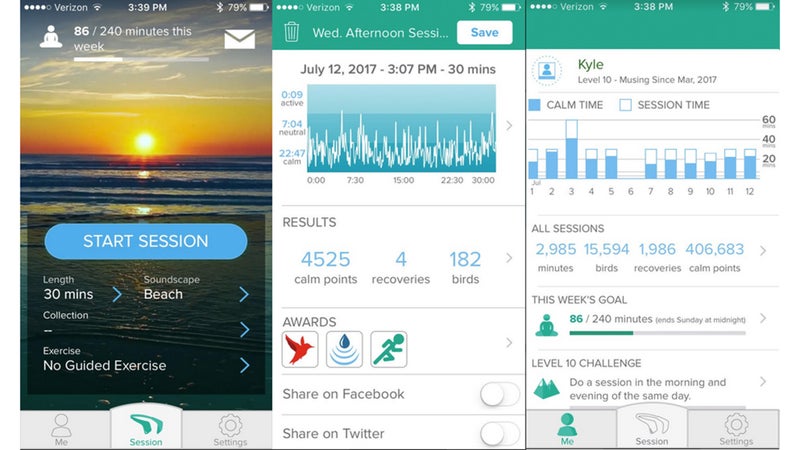By now you’ve probably been inundated with stories about how good meditation is for you. Like a lot of people, I’ve tried it over the years but without much success at sustaining the practice. I do it for a few days or a few weeks, but something else always comes up, I get out of the habit, and I stop for long periods of time.
Part of my struggle is that even when I was good at making time for meditation each day, I was never sure if I was doing it right. Turns out this is a fairly common question for a new meditator, says Steven Leonard, founder of BodyMind Training and a meditation teacher at the Kripalu Center, a yoga and wellness institute in Stockbridge, Massachusetts. You set aside some time, you found a quiet place, and you sat in a comfortable position. Perhaps you cued up , counted your breaths, or repeated a mantra. Ten minutes later, you’re still sitting there, wondering: Is anything happening?
A slew of new products aim to answer that question. Just like a heart rate monitor can give you feedback that helps quantify whether you’re hitting your goals, companies are introducing digital headbands that claim to help you meditate better when paired with proprietary apps. Commercial companies like ($99), ($799), and ($249) produce electroencephalography (EEG)-based meditation headbands that monitor your brain waves while you meditate and reveal what state your mind is in. I decided to test one over five months.
I chose the Muse, which has a slim profile and a moderate price and is one of the more popular EEG meditation devices around—the company says it’s used by thousands of health practitioners and more than 100 universities around the world. The Muse pairs with an app and plays soothing sounds from your phone while the headband measures your . Several kinds of brain waves are prevalent during different activities and states of mind: delta (deep sleep), theta (REM sleep, daydreaming, and deep meditation), alpha (awake but relaxed), beta (awake and active), and gamma (awake and hyperalert). EEG technology has been used to measure these waves for a century, often to diagnose brain disorders like epilepsy, but the basic measurements of brain waves can be applied in all sorts of situations; for example, when meditating, EEG users might observe higher alpha and theta activity.
“Just like the telescope helped us explore outer space, technology like EEG can likely help us explore our inner space.”
“Neuroscience is still in its infancy—it hasn’t even scratched the surface of understanding the process of meditation,” says Leonard, who, along with neuroscientist Andrew Heusser, co-leads a program called the . In the program, the scientists use EEG to show participants’ real-time changes in brain wave states during various forms of meditation.
When I first put on the headband and connected it to my phone via Bluetooth, I found it easy to sit quietly, and I found the default background noise (waves crashing on a beach) soothing. The way Muse is set up, you hear the waves (and sometimes rain) when your mind is less calm. When your brain is calmer, you hear the sound of birds. The changing sound is not meant to calm you, but rather to let you know that your mind is calm—it’s a real-time window into your brain, giving you real-time affirmation that your brain is calm. (Or, alternatively, that it isn’t.)

After each session, you can look at your phone to see the results from both that session and those from the past two weeks. The app displays graphs showing how long you meditated, your score based on the app’s reward system, and what percentage of time you spent in a “calm” state, according to your brain waves. (The company declined to reveal what, exactly, the app is measuring when reporting “neutral” and “calm” states beyond the fact that it includes all five brain waves in its algorithm.) The more time you spend in a calm state, the higher your score for that session; you get one point for each second your brain is in a neutral state and three for each second it’s calm. Muse also lets you know how many days in a row you have consistently used the headband to meditate.
Before using Muse, most sessions felt pretty similar to each other: I concentrated on my breath as much as I could, but I spent most of my time shifting in and out of thought. Sessions with Muse were similar—it wasn’t a miracle cure, clearing my mind of all distractions—but the feedback helped me interpret them differently. For example, without Muse, I had imagined the key to being at ease was absence of thought. But now I saw that thoughts didn’t necessarily disrupt my calm. As long as I eventually brought my wandering mind back to my breath, those detours didn’t immediately change my brain waves. As far as my mind was concerned, I was still in a meditative state.
The main benefits of Muse are as simple as that: When I have confidence that something I’m doing is having a specific positive effect, I’m more likely to want to do it. Over the course of a month, I was able to extend my sessions to 30 minutes, keeping my brain in a calm state the entire time, and to meditate more often. In fact, after I began using Muse, I meditated for 90 days straight.
Meditation didn’t make me run faster, but it did help me handle the mental burden of running fast.
At the same time that my meditation practice became more consistent, I started to notice an overall calmer sense of the world within my daily life. (I was also getting enough sleep—training for ultramarathons helped with that—and I was eating well. I doubt Muse would have made up for bad habits; rather, it amplified good habits.) I was less easily fazed by minor annoyances and felt better throughout the day. My attitude toward training was in line with my attitude toward meditating, and it was easier to be consistent about all the habits I was forming. While Muse wasn’t necessarily responsible for all these changes, it certainly contributed.
Since developing a consistent meditation practice with Muse, I’ve been able to let go of negative feelings like the ones I experienced during a 50K race this summer. Throughout the run, I felt mentally calm and alert despite my faster-than-usual pace. When my legs hurt, and they often did during the final ten miles of the race, I repeated a mantra that came to me during a race last year: “This is exactly where I want to be.” I felt the pain or discomfort lessen and then disappear. Meditation didn’t make me run faster, but it did help me handle the mental burden of running fast.
The most surprising effect of using Muse was being able to see how running affects my post-run meditation. On days when I ran five to 15 miles, Muse told me that my mind was very calm during meditation, almost without exception. In contrast, on rest days, my mind was much more likely to be distracted. I also found that more isn’t always better: On big days, when I covered 20 to 30 miles, Muse indicated that my mind was often very distracted, akin to what it was like on a rest day. I don’t think that means long runs are bad for me any more than off days are; rather, each type of activity plays a specific role in my training program and mental state.
Sound like something you might benefit from? Keep these three things in mind.
Look for Feedback
Whether or not you decide to use a device like Muse, feedback is one of the keys to learning. Top performers in sport, art, and industry use feedback to improve what they are doing. That’s what your mile splits on your watch are—feedback. Something as intangible as meditation can be frustrating in part because it doesn’t provide immediate feedback, and Muse helps solve that.
Don’t Be Scared Off
Until recently, few athletes would have thought that meditation could be useful in their own lives. Keep an open mind about the tools you can use to improve your athletic performance and everyday life.
Training Wheels Are OK
I don’t think I’ll be using Muse forever. I’ve already begun doing at least half my meditation sessions without it. Though meditation can be trying when first starting out, it offers long-term results. After several months, I feel better both immediately after a session and throughout the day—meaning it’s probably time to remove the training wheels.


